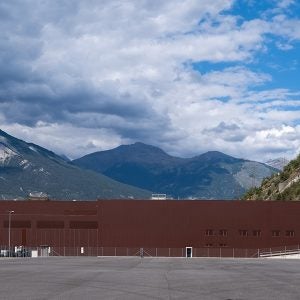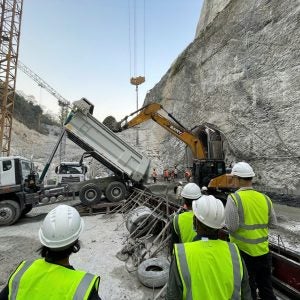For a long time, dams were considered as a clean, emissions-free way of generating energy. However, recent studies have produced conflicting results, some suggesting that reservoirs may be significant sources of greenhouse gases (GHG), others indicating a small impact on the total carbon emissions.
To quantify the change of GHG fluxes in a river basin caused by the creation of a reservoir requires consideration of exchanges before and after its construction. However, there has been no scientific consensus on how to measure the GHG status of freshwater reservoirs.
This lack of consensus has impeded progress in decision-making on specific activities. For example, scientific guidance is needed to support the construction of national GHG inventories; develop methods (measurement and predictive modelling) of establishing the GHG footprint of new water infrastructure projects; and to quantify more precisely the carbon offsets of hydropower projects for GHG emission trading. More generally, policymaking on energy, water and climate action is compromised by the current lack of understanding. This has a global impact, especially on planning in developing countries.
Despite strong efforts to build consensus in assessing the GHG status of reservoirs, many uncertainties have remained. Specific problems have been the lack of standard measurement techniques, limited reliable information from a sufficient variety of sources, and the lack of standard tools for assessing net GHG exchange from existing and planned reservoirs.
As a consequence, comparisons between the available results are not an easy task, requiring intense interpretation of the data and often leading to unreliable estimates of the actual influence of freshwater reservoirs on the emission of GHG.
The main difficulties in the current stage of knowledge are:
• The great majority of the available literature data are large gross emissions from tropical young reservoirs, including natural and unrelated anthropogenic sources. Consequence: overestimates of the GHG emissions and a bad perception of the real role of freshwater reservoirs over climate change.
• There was no agreed procedure to estimate the net emissions of reservoirs, and data have not been obtained in a standard procedure (each study uses different measurement procedures and equipment). Consequence: comparisons between the available results are not an easy task, requiring intense interpretation of the data.
• It is still difficult to have a representative sample of existing and planned reservoirs (most existing studies have been made in tropical young reservoirs, more prone to large emission rates). Consequence: GHG emissions from reservoirs at the global scale are subject to large uncertainties.
The UNESCO/iha GHG Research Project – GHG Status of Freshwater Reservoirs
The UNESCO/iha GHG Research Project – GHG Status of Freshwater Reservoirs (the project), hosted by the international-hydropower-association (IHA), in collaboration with the international-hydrological-programme (ihp) of UNESCO, came as a response to these challenges and needs. It aims to improve understanding on the impact of reservoirs on natural GHG emissions in a river basin, obtaining a better comprehension on current methodologies and helping to overcome knowledge gaps.
The project’s main goals were identified as:
• Developing, through a consensus-based, scientific approach, detailed measurement guidance for net GHG assessment.
• Promoting scientifically rigorous field measurement campaigns, and the evaluation of net emissions from a representative set of freshwater reservoirs throughout the world.
• Building a standardised, credible set of data from these representative reservoirs.
• Developing predictive modelling tools to assess the GHG status of unmonitored reservoirs and potential sites for new reservoirs.
• Developing guidance and assessment tools for mitigation of GHG emissions at sites vulnerable to high net emissions.
The project has benefited from a consensus-based, scientific approach involving collaboration among many research institutions and scientists. All the resulting deliverables have been reviewed by the project’s peer-review group, which comprises some 160 researchers, scientists and professionals working in this field, from more than 100 institutions, including universities, research institutes, specialist companies, non-governmental organisations and sponsoring agencies. Only after passing this review process, are the products approved for publication on the internet pages of UNESCO and of IHA.
The concept of net GHG emissions
The concept of net GHG emissions is of fundamental importance for the assessment of the GHG status of freshwater reservoirs.
Net GHG emissions from man-made freshwater reservoirs are defined here as the GHG impact from the creation of these reservoirs (or the GHG status of freshwater reservoirs). This means that net GHG emissions are the difference between the emissions with and without the reservoir, in the portion of the river basin affected by the reservoir, including upstream, downstream and estuarine areas.
Net emissions cannot be measured directly; the results of field measurements are considered to be gross emissions, including effects from natural and unrelated anthropogenic sources, both for pre- and post-impoundment conditions.
In this study, net GHG emissions are estimated as the difference between gross GHG emissions calculated for pre- and post-impoundment conditions, from the portion of the river basin influenced by the reservoir (both terrestrial and aquatic ecosystems) at the whole watershed level, including upstream and downstream. Emissions associated with land-use change (including deforestation, agricultural practices, and urbanisation) have to be approached with care, as they do not always directly result from the dam construction. Carbon stock change should also be assessed, including carbon buried in sediments. In accordance with IPCC (2006), the lifecycle assessment for net GHG emissions is 100 years.
Emissions due to the above-water decay of flooded trees and other vegetation, as well as emissions from the construction phase of the dam, including the use of fossil fuels by machinery and the production of building materials such as concrete, steel, fuel, and others are not considered to be important for the reservoir’s whole life cycle. However, they can be accounted by the use of standard procedures for life-cycle assessments (LCA) of constructions.
Moving towards standard measurement guidelines: the ghg measurement guidelines for freshwater reservoirs
The UNESCO/iha GHG research project reached an important milestone with the publication of the GHG Measurement Guidelines for Freshwater Reservoirs, a pioneering document, describing standardised procedures for field measurements and estimation of the impact of the creation of a reservoir over the GHG emissions.
These Guidelines put together the main products developed by the UNESCO/IHA GHG Research Project, under a consensus-based, scientific approach, resulting from an intensive international collaborative initiative, and set the basis for the next stages of the research, with the application of the agreed protocols in the field. It comprises five sections:
• Executive Summary.
• Concepts and Processes: provides the theoretical basis for producing guidance for standardised measurements to assess net GHG emissions associated with man-made freshwater reservoirs, aiming to ensure objective assessments and to ease comparison, transferability and the global use of data.
• Field Manual: provides instructions on the field methods and equipment necessary to estimate GHG emissions, under pre- and post-impoundment conditions. It provides qualified technicians and scientists with a protocol to make GHG emission measurements in the field. More specifically, the Field Manual includes instructions on how to conduct GHG measurements in terrestrial (forest, grass and peatland) and aquatic (wetland, lake, river and reservoir) ecosystems in terms of GHG emissions and carbon and nitrogen stocks.
• Calculation Manual: presents the standard procedures required to calculate net GHG emissions resulting from the creation of a reservoir in a river basin. This manual is designed to be used with the data obtained from the procedures described in the companion Field Manual.
• Glossary.
For the first time, the GHG Measurement Guidelines provide individuals responsible in this area with a comprehensive tool to assess the GHG status of Freshwater reservoirs, including definitive guidance on measurement and qualification of emissions resulting from the formation of reservoirs.
With the concept of global application being at the forefront of the development of the GHG Measurement Guidelines, IHA has ensured that the methodology contained within the publication is applicable to all climate types and reservoir conditions. By providing the tools required to determine net GHG emissions in a selected set of reservoirs, IHA’s intention is to ensure that the results gained will be utilised to develop predictive tools, thereby helping to identify the sites where measurements are most needed and thus reducing the necessity of such intensive field measurements in the future. It is anticipated that shared results from the use of these GHG Measurement Guidelines will contribute to this intention.
IHA would encourage any organisation that has an interest in GHG emissions from freshwater reservoirs to utilise the GHG Measurement Guidelines. The publication is available in both printed and electronic (pdf) formats and can be ordered directly from the IHA website .
The Guidelines are for planning and conducting measurement campaigns to estimate net GHG emissions from freshwater reservoirs before and after their construction. They aim to ensure that assessments are objective, and to make it easier to compare, transfer and use data globally (subject to rules of access). They also aim to promote scientifically sound evaluation of the GHG exchange resulting from freshwater reservoir construction.
The GHG Measurement Guidelines are intended to be applied worldwide, for all climate types and reservoir conditions, and for freshwater reservoirs of all types and purposes. As part of the UNESCO/IHA GHG Research Project, the GHG Measurement Guidelines are intended for assessing GHG emissions in a sample of representative sites throughout the world. Data from this initiative will help improve predictive capacity.
The GHG Measurement Guidelines are not meant as a general method for routine assessment and monitoring in existing and future reservoirs. Rather, they propose a standard method to allow easier comparison and transfer of detailed field data collected from comprehensive research studies on reservoirs and watersheds, looking at all the underlying processes and their relative significance. So the Project’s ultimate goal is to develop predictive modelling tools that can replace the intensive monitoring described in such data. These modelling tools would apply to reservoirs in general, and would thus remove the need to perform the evaluations proposed in this version of the Guidelines.
The present version was developed to provide the standards for assessing net GHG emissions in a representative set of reservoirs. At the end of this measurement programme, the available data may justify a two-tier approach to assessment in the future: [1] assessments of key parameters to check whether there are likely to be significant emissions; [2] if necessary, more intensive monitoring to quantify the net GHG emissions.
This tiered approach makes the GHG Measurement Guidelines relevant in assessing emission estimates for several different uses including carbon trading mechanisms; developing national GHG inventories; complying with national environmental requirements; assessing the GHG status of new reservoir sites and of existing unmonitored reservoirs; planning mitigation; and carrying out scientific research.
The GHG Measurement Guidelines are being developed as a ‘living document’. As further experience is gained and uncertainties are reduced, they will be updated with new information.
The way forward
The project is pioneering a first step towards standardising equipment and procedures to accurately evaluate the net GHG impact of freshwater reservoirs. The protocol describes the required standard procedures, evolved through a consensus-based approach, that are now ready to be applied in a range of reservoirs to help get representative, comparable and transferable data that will allow scientifically sound evaluation of the GHG footprint of these reservoirs.
The next steps include:
• Promotion of field measuring programmes in compliance with the proposed method;
• Capacity-building training programmes for taking such field measurements;
• Development of predictive modelling tools to assess the GHG status of unmonitored reservoirs and potential new reservoir sites;
• Development of guidance and assessment tools to mitigate GHG emissions at vulnerable sites.
As the project has progressed, the importance of a capacity-building training programme has been identified. Such training would ensure a proper understanding and application of the standard procedures developed under the Project. This, in turn, would provide enough data to allow the science to move forward and build the necessary predictive modelling capacity.
An essential next step is to develop adequate predictive modelling tools to assess the GHG status of unmonitored reservoirs and potential sites for new reservoirs. These tools, once validated, could provide the basis for developing appropriate guidance on national GHG inventories, and to quantify carbon offsets at the project level, without the need for specific field measurement programmes.
It is important to carry forward the UNESCO/IHA forum process, including workshops and peer-review evaluation. The process is costly in time, resources and money and those who take part mainly do so as volunteers. It makes a crucial contribution to reinforcing the strong, transparent, consistent approach that the Project needs.
Joel Avruch Goldenfum is a Professor at the IPH/UFRGS (Institute of Hydraulic Research of the Federal University of Rio Grande do Sul, Brazil), in leave of absence to work at IHA (International Hydropower Association), as Project Manager of the UNESCO/IHA Greenhouse Gas (GHG) Research. He receives a research grant from CNPq (Brazilian National Council for Scientific and Technological Development)
During the development of this research, the Project received sponsorship from CTGPC (China Three Gorges Corporation), edf (Electricité de France), HEA (hydro-equipment-association), IAI (International Aluminium Institute), SN Power, Statkraft and the World Bank






